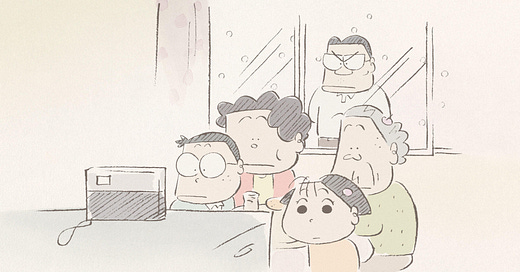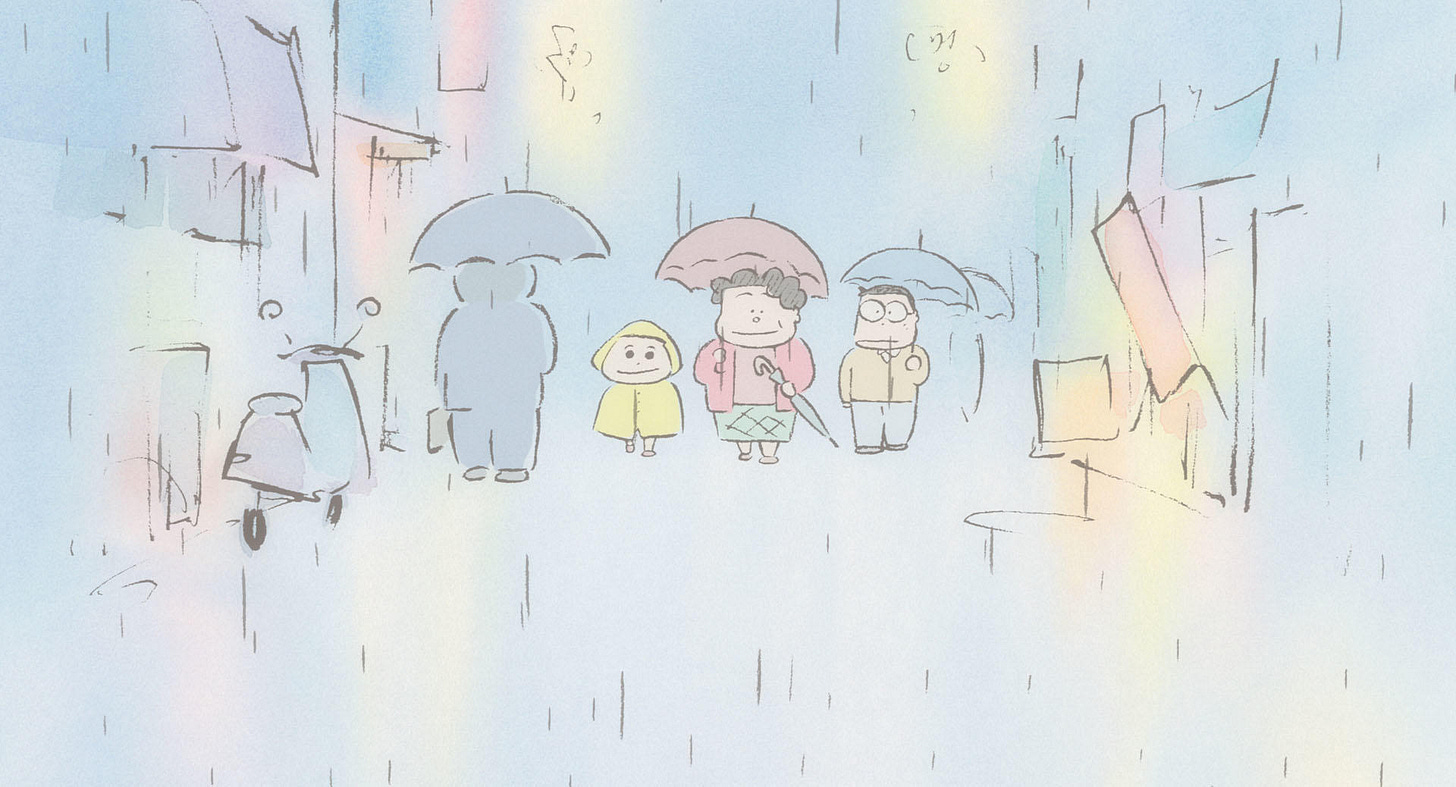Hellloo dearest :) Here’s hoping we have a great October. That sounded like an ending salutation but I think it’s nice to begin with hope.
Growing up, I romanticised October way too much. The season of fall punctuated by a flare of colours, halloween… but what’s fall and halloween in Chennai?? Only a very western idea sold via every rom-com, sit-com. October, here, is pleasant but somewhat languid. A relief from September’s hot-and-not mood swings and slow drag into the November monsoons. The only consolation is that there are festivals and holidays to look forward to. And it’s custard apple season! My mother and I sometimes spend quite evenings gently scooping and peeling out the thin and sweet flesh of the custard apple from its many many seeds (using just our teeth of course). I think one requires skill and good levels of patience to enjoy the custard apple.
I recently watched My Neighbors The Yamadas by the brilliant Isao Takahata and immediately fell in love. Based on Hisaichi Ishii’s manga called Nono-chan, the film is a series of vignettes on a family of five (and their dog pochi) from Japan. It is a quirky slice-of-life, absolutely funny, and at the same time poignant collection. In a way, it reminded me of Edward Yang’s Yi Yi. I especially loved the TV remote scene and the one where the family is lost in a shopping mall.
Photo courtesy Studio Ghibli
Isao, in one of his interviews, is talking about why his style seems minimal. Impressionistic, they call it. He’s done that in Princess Kaguya as well. He says that he did not care much for the 3D style of animation and instead worked on “a method of reduction”. “Of not drawing everything on the screen, in order to stimulate people’s imagination and raise the level of artistry,” he said in one interview. He says he believes in a style that has the “power to stir people’s imagination and awaken their memories.” I’ve always been drawn to this idea, of giving just enough to stimulate the reader/viewer. I think it is a very liberating way and brings about an intimacy between the artist and the viewer.
I also liked the Haikus (by poets like Basho, Buson, etc) that were interspersed in this film with beautiful references to the seasons. I hope you can find the time to watch this film, its on Netflix. Isao’s Only Yesterday is brilliant too. Grave of Fireflies you can watch if you’ve got a stronger heart.
The scent of plums
on a mountain path
suddenly dawn.
A spring shower
dressed for rain
talking as they go.
Photo courtesy Studio Ghibli
Turn towards me
I'm lonely too
the Autumn dusk.
Im still reading the Neapolitan novels (book 4 now) and it feels like a long term relationship. I decided to take a short break with some pulp, so I picked up Everything I Never Told You by Celeste Ng (a thriller). I read that its a page turner and I hope it can sustain my finicky attention spans. On a related note, I find best sellers can be a major waste of time. Earlier this year I tried bingeing on best sellers (vanishing half, where the crawdads sing, normal people, eleanor oliphant is completely fine, etc) just to understand what made them that. But looking back, I have nothing to show. I think consumption of “popular” books and movies can be avoided if you value your time. “Oh yeah, I’ve heard of it,” is more than a sufficient answer if you want to sound smart during conversations.
Last Sunday I woke up with an urge to read a short story in Tamil. I picked up a book in random - Dilip Kumar’s Kadavu. I savoured the uncertainty, walking blindly into a new world (it can be so rarely felt these days) and I could have lost interest if the first story had not been that of a paati. I am a sucker for stories about old woman, T Janakiraman’s Vendam Poosani is another heart- wrenching favourite. Kadavu begins with an old woman on her death bed and a whole colony waiting for her to pass. At first I thought it was a Hindi story translated in Tamil (that’s how openly I picked up the book). But I was surprised to find that the story is set in Chennai’s Kondithope, Broadway area that is home to Marwadis and other north Indian communities. Dilip Kumar himself, I learnt later, is a Gujarati who grew up in the very same area and is a Tamil writer of renown. How did I not know about him and his stories for so long, I wondered and felt bad for not finding him sooner. The story is brilliantly written. Hilarious, by which you’re laughing mid sentence and not just chuckling and smiling to yourself. The narrator is a young man who is telling us everything he knows about this paati from his neighbourhood. Of what he heard, what he knows, what he saw. And paati is a riot. She’s brazen, funny and insightful. She’s sweet, sour and spicy all at once. I haven’t met or heard of another and immediately I developed a fondness towards her. My understanding is that women (or people) generally tend to seek for pieces of themselves in older women, women who have lived full lives, who have seen it all. Women like the earth, with their warmth and knowledge and energy.
The paati in Yamadas too has a distinct charm to herself. She’s looking at a cherry blossoms tree and wondering, “how many more flowerings do you think I’m going to see in this life?” She’s seen enough you might think, she’s already 70. But paati baffles us with “30?” I am also reminded of all the grandmothers from Koreeda’s After the Storm and Still Walking and Shoplifters. Almost all his grandmothers are spectacularly portrayed by Kirin Kiki that it’s hard for me to imagine a different Japanese grandmother.
I don’t think we have fully come to appreciate women who have lived to see 70, 80 years of age. There’s plenty more to what we already know. Paatis are not just cute and adorable or a repository of memories and tips. Paatis are more than your very first story tellers, your personal go-tos.
At the end of Kadavu, I was so satisfied that I carried that feeling of contentment, of peace, of being full the entire day. I even went to bed happy (another rare feeling). I think that is what a good creation or work of art is capable of doing. I don’t think we can find contentment anywhere else. There’s no contentment in life, according to me, without consuming good art.
I also wanted to leave this poem for you to read and ponder and hopefully help you slow down.
Hurry We stop at the dry cleaners and the grocery store and the gas station and the green market and Hurry up honey, I say, hurry, as she runs along two or three steps behind me her blue jacket unzipped and her socks rolled down. Where do I want her to hurry to? To her grave? To mine? Where one day she might stand all grown? Today, when all the errands are finally done, I say to her, Honey I'm sorry I keep saying Hurry— you walk ahead of me. You be the mother. And, Hurry up, she says, over her shoulder, looking back at me, laughing. Hurry up now darling, she says, hurry, hurry, taking the house keys from my hands. - Marie Howe "The Kingdom of the Ordinary", W.W. Norton, 2008
I first read this on Irshaad Instagram page. I was taken by the changing imagery in this poem. At first we’re not sure who is talking and by the end of the first stanza, we get to understand that it could be a parent and by the end of the second, we understand that it is the mother. How then the entire sequence changes, from the mother passing it on to the daughter to the daughter taking over and becoming the mother.
We hurry, run and trot and jog and order everyone around to hurry and gallop and keep pace until it is our turn slow down, take a breath and turn back only to be told to hurry up and to pick up the pace and run.
I’d love to hear from you, to know what you like or don’t like about my letters. You could always write to me at anjanashekar@substack.com or if you’ve been to my place, you’ll know where to find me. Write to you soon.
Until then,
A





